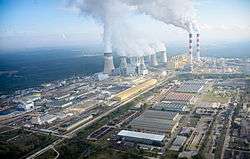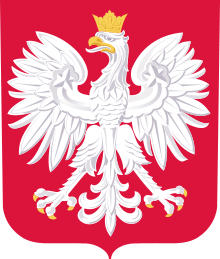Energy in Poland

Energy in Poland describes energy and electricity production, consumption and import in Poland.
In 2009, Poland was world's 9th largest hard coal producer. The country is also the second largest coal consumer in Europe behind Germany.[1]
Overview
| Energy in Poland[2] | ||||||
|---|---|---|---|---|---|---|
| Capita | Prim. energy | Production | Import | Electricity | CO2-emission | |
| Million | TWh | TWh | TWh | TWh | Mt | |
| 2004 | 38.2 | 1,067 | 917 | 157 | 131 | 296 |
| 2007 | 38.1 | 1,129 | 845 | 294 | 140 | 305 |
| 2008 | 38.1 | 1,138 | 830 | 352 | 142 | 299 |
| 2009 | 38.2 | 1,093 | 785 | 352 | 137 | 287 |
| 2010 | 38.2 | 1,180 | 784 | 373 | 144 | 305 |
| 2012 | 38.5 | 1,178 | 797 | 402 | 148 | 300 |
| 2012R | 38.5 | 1,138 | 831 | 360 | 148 | 294 |
| 2013 | 38.5 | 1,135 | 825 | 301 | 150 | 292 |
| Change 2004-10 | 0.0 % | 10.6 % | -14.5 % | 138 % | 10.3 % | 3.1 % |
| Mtoe = 11.63 TWh, Prim. energy includes energy losses that are 2/3 for nuclear power[3]
2012R = CO2 calculation criteria changed, numbers updated | ||||||
| Diesel | Gasoline | Natural gas | Coal | Electricity | ||
|---|---|---|---|---|---|---|
| per unit | liter | liter | m3 | GJ | GJ | MWh |
| Excise | 1.459 | 1.669 | 1.28 | 1.28 | ||
| Environment | ||||||
Coal
In 2009 Poland produced 78 megatonnes (Mt) of hard coal and 57 Mt of brown coal.
Coal and the environment
Coal mining has far-reaching effects on local water resources. Coal mining requires large amounts of water. Mining activities have dropped the water level of Lake Ostrowskie by almost two meters in the Kuyavia–Pomerania and the lakes in the Powidz Landscape Park. According to Poznań's University of Agriculture, the water drainage in the Kleczew brown coal mining areas has formed craters in the area.[1]
Coal and the public
In April 2008, five thousand people demonstrated in Kruszwica to protect cultural heritage and the nature reserve at Lake Gopło. This was the first protest of its kind in the country's history. Gopło Millennium Park (Nadgoplański Park Tysiąclecia) is protected by the European Union's Natura 2000 program and includes a major bird sanctuary. The Tomisławice opencast mine (less than 10 kilometers away from the Kruszwica mine) was due to open in 2009.[1]
Coal and business
The Bełchatów Power Station in the Łódź region supplies almost 20% of Poland's energy. It is the largest brown coal power plant in Europe.
Electricity
In 2008, a net 143 TWh of electricity were produced in coal-based power plants.[5]
Renewable energy
The Polish government had plans to reach 2,000 MW in wind power capacity and a 2.3% share of wind generation in domestic energy consumption by 2010.[6] By the end of 2010, the capacity stood at 1,107 MW.[7]
A binding European Union resolution stipulates a 15% renewable energy target in 2020. According to the Polish National Renewable Energy Action Plan, the 2020 target is 19% of the national energy capacity (15.2 TWh wind power and 14.2 TWh biomass), 17% in heating and cooling, and 10.1% in transport. EWEA's 2009 forecast suggests a higher wind capacity of 10–12 GW (2020).[8]
If Poland had the same wind power density as Denmark, there would have been 23 GW of wind power by the end of 2008.[9]
| EU and Poland Wind Energy Capacity (MW)[10][11][12][13] | ||||||||||||||||
|---|---|---|---|---|---|---|---|---|---|---|---|---|---|---|---|---|
| No | Country | 2012 | 2011 | 2010 | 2009 | 2008 | 2007 | 2006 | 2005 | 2004 | 2003 | 2002 | 2001 | 2000 | 1999 | 1998 |
| - | EU-27 | 105,696 | 93,957 | 84,074 | 74,767 | 64,712 | 56,517 | 48,069 | 40,511 | 34,383 | 28,599 | 23,159 | 17,315 | 12,887 | 9,678 | 6,453 |
| 9 | Poland | 2,497 | 1,616 | 1,107 | 725 | 544 | 276 | 153 | 83 | 63 | 63 | 27 | 0 | 0 | 0 | 0 |
Global warming
Poland opposed the 2009 EU proposal to support developing countries in applying measures against global warming, at a cost of 5-7 billion € during the years 2010–2012.[14]
See also
| Wikimedia Commons has media related to Energy in Poland. |
References
- 1 2 3 "The True Cost of Coal" (PDF). Greenpeace. November 27, 2008. pp. 6, 54–57. Retrieved 2011-05-22.
- ↑ IEA Key World Energy Statistics Statistics 2015, 2014 (2012R as in November 2015 + 2012 as in March 2014 is comparable to previous years statistical calculation criteria, 2013, 2012, 2011, 2010, 2009, 2006 IEA October, crude oil p.11, coal p. 13 gas p. 15
- ↑ Energy in Sweden 2010, Facts and figures, The Swedish Energy Agency, Table 8 Losses in nuclear power stations Table 9 Nuclear power brutto
- ↑ Michel, Sharon. ENERGY PRICES AND TAXES, COUNTRY NOTES, 3rd Quarter 2015, page 40. International Energy Agency, 2015
- ↑ "Key World Energy Statistics" (PDF). International Energy Agency. 2010. p. 54. Retrieved 2011-05-22.
- ↑ GWEC "Global Wind Report" Check
|url=value (help) (PDF). Global Wind Energy Council. 2006. p. 25. Retrieved 2011-05-22. - ↑ "Wind in Power – European Statistics" (PDF). The European Wind Energy Association. 2010. Retrieved 2011-05-22.
- ↑ "EU Energy Police to 2050" (PDF). The European Wind Energy Association. March 2011. Retrieved 2011-05-22.
- ↑ "Pure Power – Wind Energy Targets for 2020 and 2030" (PDF). The European Wind Energy Association. 2009. Retrieved 2011-05-22.
- ↑ EWEA Staff (2010). "Cumulative installed capacity per EU Member State 1998 - 2009 (MW)". European Wind Energy Association. Retrieved 2010-05-22.
- ↑ EWEA Staff (February 2011). "EWEA Annual Statistics 2010" (PDF). European Wind Energy Association. Retrieved 2011-01-31.
- ↑ EWEA Staff (February 2012). "EWEA Annual Statistics 2011" (PDF). European Wind Energy Association. Retrieved 2011-02-18.
- ↑ Wind in power: 2012 European statistics February 2013
- ↑ "Puola ei suostu ilmastotalkoisiin" (in Finnish). YLE. October 2, 2009. Retrieved 2011-05-22.
